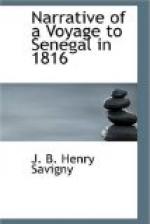Whence comes the name of Arguin? who gave it to this gulph? If we consider the heat of the sun which is experienced here, and the sparkling of the sandy downs which compose the coast, we cannot help remarking that Arguia in Phenician means what is luminous and brilliant, and that in Celtic, Guin signifies ardent. If this name comes from the Carthaginians, who may have frequented these coasts, they must have been particularly struck with their resemblance to the famous Syrtes in their own neighbourhood, which mariners took so much care to avoid.
Exercitas aut petit Syrtes Noto.
Some division of territory, or of pasturage among the hordes of the desert, was doubtless the cause, that the Europeans, who desired to carry on the gum trade, formerly chose the dangerous bay of Portendic, surrounded by a vast amphitheatre of burning sands, in preference to Cape Merick. Perhaps, the Trasas of the west, could not advance to the north of this bay, without quarrelling with the other Moors, who frequent Cape Blanco. This Cape Merick seems preferrable for commerce, either as a factory, to trade with the Moors, or as a place of protection for the traders, and the fishery. Its elevation and nature, afford a facility of defence, which is not found at Portendic; where there is not at present the smallest appearance of vegetation.
The Estuary of the river, St. John, at the back of this Cape, is now entirely destitute of verdure, and humidity, and salt is abundant in the neighbourhood.
But, as we have said above, it is when we penetrate a little into the interior, that an immense country, rich in the gifts of nature, invites European cultivation, and offers the fairest prospect of success for the colonial productions.




